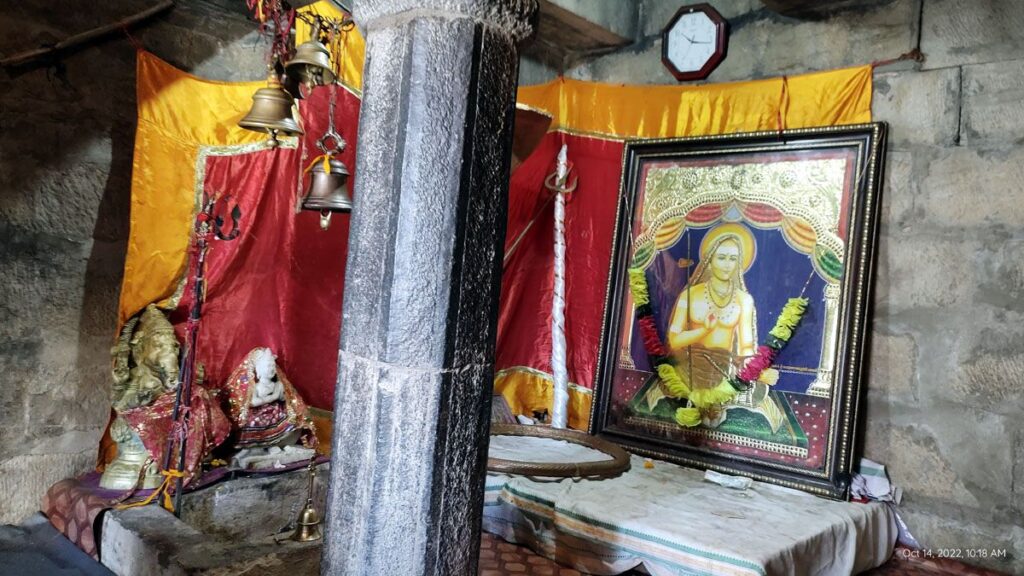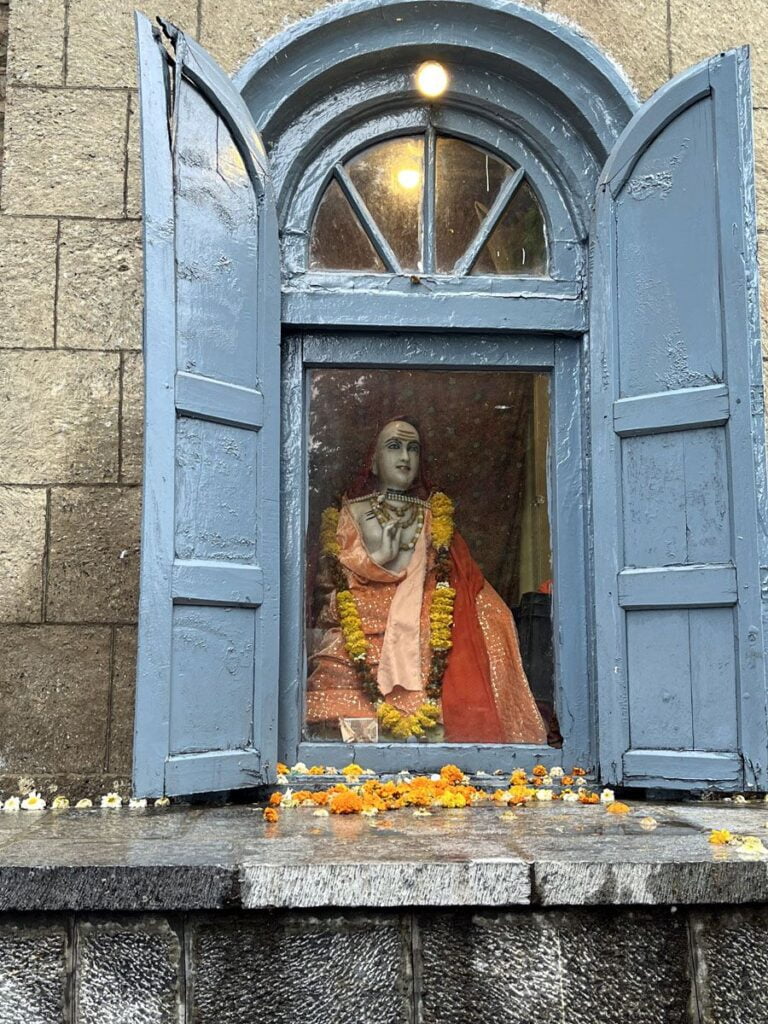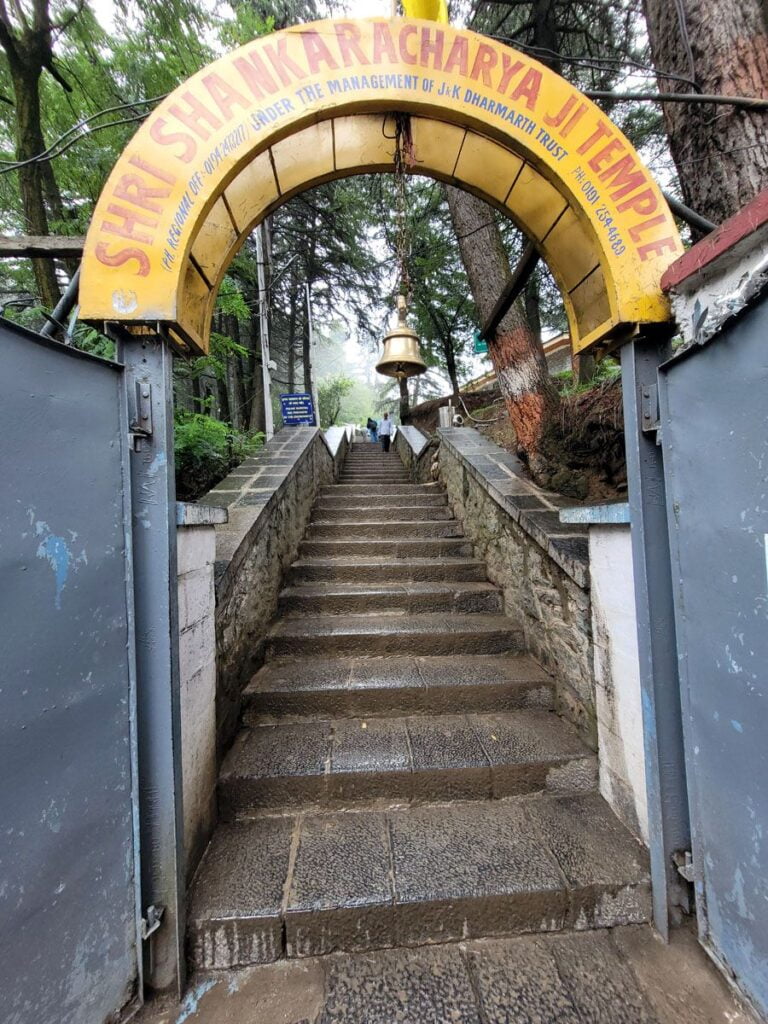Shankaracharya Temple | Jyeshteshwara Temple
The Shankaracharya Temple, also known as the Jyeshteshwara Temple, is a Hindu temple dedicated to Lord Shiva, standing majestically atop the Shankaracharya Hill in Srinagar, Jammu and Kashmir, India.

Contents
Shankaracharya Temple History:
Unveiling the Origins:
While the exact date of construction remains shrouded in mystery, some believe it dates back to the 3rd century BC, built by King Gopaditya. Others attribute its origins to the 8th century AD, crediting Adi Shankara, the revered Hindu philosopher, for establishing it. Regardless of its precise beginnings, the temple has transcended generations, bearing witness to the rise and fall of dynasties, invasions, and the changing tides of Kashmir’s history.
A Tapestry of Influences:
Over the centuries, the temple has absorbed influences from various faiths and cultures. Architectural elements hint at Buddhist and Persian touches, while the octagonal base and shikhara style reflect Kashmiri craftsmanship. This amalgamation further adds to the temple’s unique charm, making it a melting pot of artistic expressions.
Triumph Over Adversity:
The Shankaracharya Temple has endured its fair share of trials. Facing destruction during invasions and natural calamities, it was repeatedly rebuilt, each time rising from the ashes like a phoenix. This unwavering spirit symbolizes the temple’s significance as a beacon of faith and cultural identity for the people of Kashmir.
Beyond the Physical Structure:
The Shankaracharya Temple is more than just bricks and mortar. It’s a spiritual sanctuary, attracting devotees from all walks of life seeking solace and blessings. The serene atmosphere, coupled with the breathtaking panoramas of Srinagar valley, creates an ambiance of profound peace and introspection.
A Legacy Preserved:
Today, the Shankaracharya Temple stands as a national monument protected by the Archaeological Survey of India. Its preservation ensures that future generations can experience its historical and spiritual grandeur.
Read More>> Anjani Mahadev Temple: Waterfall on Shivling

Legend of Shankaracharya Temple:
1. The Vision of Adi Shankara:
- The most prominent legend links the temple to the renowned 8th-century philosopher and scholar, Adi Shankara. On his travels across India, Shankara is said to have been drawn to the serene atmosphere of the hill.
- As he meditated near a spring, a divine vision of Lord Shiva himself appeared, urging Shankara to establish a holy seat at this sacred spot. Heeding the divine call, Shankara is believed to have founded a monastery and consecrated the existing temple dedicated to Lord Shiva, solidifying its significance in Hindu tradition.
2. The Benevolent Snake and the Pious Frog:
- Another charming legend paints a picture of compassion and the inherent sacredness of the hill. As the story goes, Shankara, while resting near the Tunga River, witnessed a remarkable act of kindness.
- A venomous snake, instead of attacking a pregnant frog seeking shelter from the scorching sun, unfurled its hood to provide shade. This display of benevolence deeply resonated with Shankara, who recognized the hill as a place imbued with profound virtue and chose it as the location for his first Peetham (monastery).
Read More>> Kundrathur Murugan Temple Chennai

Myths and beliefs of Shankaracharya Temple:
1. Origin and Name:
- While the exact date of construction remains a mystery, a popular belief associates the temple with the renowned philosopher and theologian Adi Shankara. Legend says he visited the hill in the 8th century CE and established the temple, leading to its current name.
2. Prophecy and Miracles:
- A Kashmiri Pandit legend associates the hill with Prophet Yuz Asaf, who supposedly resided and renovated the temple before Shankara’s arrival. Some believe miraculous occurrences like levitation and celestial music were witnessed during this period.
3. Shiva and Shakti Union:
- The Gopadari Hill holds spiritual importance as the confluence of Shiva and Shakti, representing masculine and feminine divine energies. Some believe the union of these energies occurred on the hill, contributing to its sacred aura.
4. Holy Mace of Shiva:
- During the Amarnath Yatra, a holy mace associated with Lord Shiva is brought to the Shankaracharya Temple. This ritual, observed on a specific lunar phase, carries immense significance for pilgrims and strengthens the association with Shiva.
5. Conquest of Sulaiman:
- Another local legend narrates the story of Sulaiman, also known as Solomon and Sandiman, conquering the Gopadari Hill before Islam’s arrival. He is believed to have flown to the hill on his throne, showcasing his mystical powers.
6. Architectural Significance:
- The octagonal shape of the temple and the horseshoe curve architecture are believed to hold deep meaning and symbolic association with divine energies and spiritual balance.
7. Healing Powers:
- Many devotees hold strong faith in the temple’s ability to grant wishes and offer blessings. Some attribute specific areas within the temple complex with potent healing powers for various ailments.
8. Spiritual Gateway:
- The Shankaracharya Temple is considered a gateway to spiritual awakening and enlightenment. The serene atmosphere and breathtaking views from the hilltop are believed to facilitate introspection and connection with the divine.
Read More>> Shikari Mata Temple: Beyond the Hunt

Significance of Shankaracharya Temple:
Religious Significance:
- Dedicated to Lord Shiva: As a prominent Hindu temple dedicated to Lord Shiva, the Shankaracharya Temple attracts devotees from all corners of India and beyond.
- Ancient and sacred: Believed to be one of the oldest temples in Kashmir, its origin dates back to 200 BC, or even earlier according to some legends. This antiquity adds to its spiritual aura.
- Legendary associations: Mythology links the temple to significant events. It’s believed to be the site where Lord Shiva imparted knowledge to Parvati, and where Adi Shankara, the renowned Hindu philosopher, attained enlightenment.
Historical Significance:
- Witness to Kashmir’s history: Perched atop the Shankaracharya Hill, the temple has stood witness to centuries of Kashmir’s history, from the Mauryan era to the present day.
- Architectural marvel: The temple showcases a unique blend of Kashmiri and Gandharan architectural styles, featuring an octagonal base, intricate carvings, and a towering shikhara.
- Resilience through time: The temple has faced destruction and reconstruction multiple times throughout history, standing as a testament to the resilience of faith and cultural heritage.
Cultural Significance:
- Symbol of Kashmiri identity: The Shankaracharya Temple is a prominent landmark of Srinagar, serving as a symbolic representation of Kashmiri culture and heritage.
- Festivals and celebrations: The temple comes alive during festivals like Maha Shivaratri and Herath, attracting large gatherings of devotees and immersing the atmosphere in vibrant cultural festivities.
- Tourism and local economy: The temple plays a vital role in attracting tourists to Srinagar, boosting the local economy and contributing to the preservation of traditional crafts and customs.
Read More>> Thirunallar Temple of Sri Darbaranyeswara Swamy

Shankaracharya Temple Timing:
Opening Hours: 7:00 AM to 8:00 PM. Be sure to plan your visit accordingly, as parking is only allowed until 5:00 PM.
Apart from the timings, here are some other details that might be helpful for your visit:
- Best Time to Visit: The temple is accessible year-round, but the pleasant weather from May to September makes it an ideal time for sightseeing. During winter, however, the temple looks stunning covered in snow, attracting many tourists as well.
- Entry Fee: There is no entry fee for the temple.
- Time Required: It takes around 1-2 hours to explore the temple complex, including climbing the 243 steps to the top.
- Things to See and Do: Apart from the main temple dedicated to Lord Shiva, the complex also has two smaller shrines for the resident sadhus or saints. The panoramic views of Srinagar from the hilltop are truly breathtaking.
Read More>> Kapila Theertham Temple Tirupati
Places to visit near Shankaracharya Temple:
- Dal Lake: One of the most iconic attractions in Srinagar, Dal Lake is renowned for its picturesque views, houseboats, and Shikara rides. You can spend time boating, enjoying the floating gardens, and witnessing the local way of life around the lake.
- Nishat Bagh: Located on the eastern side of Dal Lake, Nishat Bagh is a beautiful Mughal garden known for its terraced lawns, flowerbeds, and stunning views of the Zabarwan Range.
- Shalimar Bagh: Another enchanting Mughal garden situated near Dal Lake, Shalimar Bagh is known for its pristine beauty, intricate water channels, and historical significance.
- Shikara Ride on Dal Lake: Don’t miss the opportunity to take a Shikara ride on Dal Lake. It’s a unique experience where you can witness the vibrant floating market, beautiful houseboats, and serene surroundings.
- Indira Gandhi Memorial Tulip Garden: If you’re visiting Srinagar during the tulip season (usually March-April), make sure to visit the Indira Gandhi Memorial Tulip Garden. It’s Asia’s largest tulip garden and offers a mesmerizing display of colorful tulip flowers.
- Old City & Markets: Explore the bustling lanes of Srinagar’s old city, visit local markets like Lal Chowk, Residency Road, and Polo View Market to experience the local culture, shop for traditional Kashmiri handicrafts, Pashmina shawls, saffron, and more.
Read More>> Sabarimala Temple: Abode of Lord Ayyappa
FAQ:
Q: Where is the Shri Shankaracharya Temple located?
The Shri Shankaracharya Temple is situated atop the Shankaracharya Hill, part of the Zabarwan Range overlooking the city of Srinagar in Jammu and Kashmir, India.
Q: What is the temple dedicated to?
The temple is dedicated to Lord Shiva, one of the principal deities in Hinduism, worshipped in the form of a Jyotirlinga (a radiant lingam). The temple is also known as the Jyeshteshwara Temple.
Q: What is the historical significance of the temple?
While the exact date of construction remains debated, the Shri Shankaracharya Temple is considered one of the oldest temples in Kashmir, with some estimates suggesting its origin in the 2nd century BC. The current structure dates back to the 9th century AD. The temple is named after Adi Shankara, the renowned Hindu philosopher and theologian who is believed to have visited the site in the 8th century.
Q: How do I reach the temple?
You can reach the temple by car or taxi, with parking available at the base of the hill. From there, you can climb the 280 steps leading to the temple. Alternatively, you can take a shared vehicle known as a “matador” or hire a pony to cover part of the ascent.
Q: What are the temple timings?
The temple is open from 6:00 AM to 8:00 PM. However, cars are only allowed from 7:30 AM to 5:00 PM.
Q: What are the rituals and poojas performed at the temple?
Several pujas and rituals are performed throughout the day, including abhishekam (sacred bath) for the Shiva lingam, darshan (viewing the deity), and chanting of hymns. Special poojas are held on festivals like Maha Shivaratri and Herath.
Q: What are some things to keep in mind when visiting the temple?
- Dress modestly, covering your shoulders and knees.
- Remove your shoes before entering the temple.
- Mobile phones and cameras are not allowed inside the sanctum sanctorum.
- Avoid carrying large bags or backpacks.
- Be respectful of the religious significance of the site.
Q: What are some other things to see and do near the temple?
- Enjoy the panoramic views of Srinagar city from the top of the hill.
- Visit the cave where Adi Shankara is believed to have meditated.
- Explore the Shankaracharya Cultural Centre located at the base of the hill.
- Take a boat ride on Dal Lake, a scenic lake in Srinagar.
Q: Why is Shankaracharya Temple famous?
- Religious Significance: Dedicated to Lord Shiva as a Jyotirlinga, it’s one of the oldest Shiva temples in Kashmir, with some estimates suggesting its origin in the 2nd century BC.
- Historical Importance: Named after Adi Shankara, the renowned Hindu philosopher, who is believed to have visited the site in the 8th century.
- Panoramic Views: Situated atop the Shankaracharya Hill, it offers stunning views of Srinagar city and Dal Lake.
- Architectural Marvel: The temple’s unique Kashmiri shikhara style architecture, with its octagonal base and pyramidal superstructure, is a sight to behold.
- Spiritual Power: Many believe the temple possesses a special spiritual aura, attracting devotees and pilgrims seeking blessings and peace.
How to reach Shankaracharya Temple:
By Air: The nearest airport to Srinagar is Sheikh ul-Alam International Airport. From the airport, you can hire a taxi or use other local transportation to reach the Shankaracharya Temple.
By Train: The nearest major railway station is Jammu Tawi Railway Station. From Jammu, you can hire a taxi or take a bus to reach Srinagar. There is no direct train service to Srinagar.
By Road: Srinagar is well-connected by road, and you can reach the city by bus or taxi. Once you are in Srinagar, you need to head towards the Shankaracharya Hill. The temple is located atop a hill known as Takht-e-Suleiman. From the city, you can hire a taxi to take you to the base of the hill.
From the Base of the Hill: Once you reach the base of the Shankaracharya Hill, you have two options to reach the temple:
- Stairs: There is a flight of stairs leading to the temple. You can climb the stairs to reach the top. It’s a bit of a trek, so wear comfortable shoes.
- Vehicle: Some vehicles can take you part of the way up the hill. From there, you will need to climb a short flight of stairs to reach the temple.

One Comment